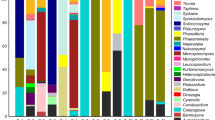Abstract
Species identification of slow-growing fungi of the genus Penicillium isolated from ancient permafrost deposits was performed using micro- and macromorphological characteristics as well as the composition of secondary metabolites. The strains producing clavine ergot alkaloids fumigaclavines A and B and festuclavine were assigned to the species P. palitans Westling 1911, whereas the strains forming ochratoxins A and B were identified as P. verrucosum Dierckx 1901.
Similar content being viewed by others
References
Pitt, J., The Genus Penicillium and Its Teleomorphic States Eupenicillium and Taloromyces, London: Academic, 1979.
Kozlovskii, A.G., Zhelifonova, V.P., Adanin, V.M., Antipova, T.V., Ozerskaya, S.M., Ivanushkina, N.E., and Gräfe, U., Penicillium aurantiogriseum Dierckx 1901: Producer of Diketopiperazine Alkaloids (Roquefortine and 3,12-Dihydroroquefortine), Isolated from Permafrost, Prikl. Biokhim. Mikrobiol., 2003, vol. 39, no. 4, pp. 393–397 [Appl. Biochem. Microbiol. (Engl. Transl.), vol. 39, no. 4, pp. 393–397].
Kozlovskii, A.G., Zhelifonova, V.P., Adanin, V.M., Antipova, T.V., Ozerskaya, S.M., Kochkina, G.A., and Gräfe, U., The Fungus Penicillium citrinum Thom 1910 VKM FW-800 Isolated from Ancient Permafrost Sediments As a Producer of the Ergot Alkaloids Agroclavine-1 and Epoxyagroclavine-1, Mikrobiologiya, 2003, vol. 72, no. 6, pp. 816–821 [Microbiology (Engl. Transl.), vol. 72, no. 6, pp. 723–727].
Kozlovskii, A.G., Zhelifonova, V.P., and Antipova, T.V., The Fungus Penicillium citrinum Thom 1910 VKM FW-800, Isolated from Permafrost Sediments, as a Producer of Ergot Alkaloids and New Quinoline Alkaloids Quinocitrinines, Prikl. Biokhim. Mikrobiol., 2005, vol. 41, no. 5, pp. 568–572 [Appl. Biochem. Microbiol. (Engl. Transl.), vol. 41, no. 5, pp. 499–502].
Kozlovsky, A.G., Zhelifonova, V.P., Antipova, T.V., Adanin, V.M., Ozerskaya, S.M., Ivanushkina, N.E., Gollmick, F.A., and Gräfe, U., Quinocitrinines A and B, New Quinoline Alkaloids from Penicillium citrinum VKM FW-800, a Permafrost Fungus, J. Antibiot., 2003, vol. 56, no. 5, pp. 188–191.
Zhelifonova, V.P., Antipova, T.V., Ozerskaya, S.M., Ivanushkina, N.E., and Kozlovskii, A.G., The Fungus Penicillium variabile Sopp 1912 Isolated from Permafrost Deposits as a Producer of Rugulovasines, Mikrobiologiya, 2006, vol. 75, no. 6, pp. 742–746 [Microbiology (Engl. Transl.), vol. 75, no. 6, pp. 644–648].
Samson, R.A. and Frisvad, J.C., Penicillium Subgenus Penicillium: New Taxonomic Schemes, Mycotoxins and Other Extrolites, Studies in Mycology, 2004, no. 49, p. 143.
Kochkina, G.A., Ivanushkina, N.E., Karasev, S.G., Gavrish, E.Yu., Gurina, L.I., Evtushenko, L.I., Spirina, E.V., Vorob’eva, E.A., Gilichinskii, D.A., and Ozerskaya, S.M., Survival of Micromycetes and Actinobacteria under Conditions of Long-Term Natural Cryopreservation, Mikrobiologiya, 2001, vol. 70, no. 3, pp. 412–420 [Microbiology (Engl. Transl.), vol. 70, no. 3, pp. 356–364].
Steyn, P.S, Ochratoxins and Related Dihydroisoconmarins, in Mycotoxins. Production, Isolation, Separation and Purification, Betina, V., Ed., Amsterdam: Elsevier, 1984, pp. 183–216.
Ivanushkina, N.E, Kochkina, G.A, and Ozerskaya, S.M, Fungi in Ancient Permafrost Sediments of the Arctic and Antarctic Regions, in Life in Acient ice, Castello, J. and Rogers, S., Eds., Proc. Prins. Univ., Princeton Univ. Press, 2005, ch. 9, pp. 127–139.
Samson, R.A., Hoekstra, E.S., Frisvad, J.C., and Filtenborg, O., Introduction to Food- and Airborne (Revised 6th Edition). The Netherlands: Centraalbbureau voor Schimmelcultures-Utrecht, 2002.
Cole, R.J. and Cox, R.H., Handbook of Toxic Fungal Metabolites, New York: Academic, 1981.
Author information
Authors and Affiliations
Corresponding author
Additional information
Original Russian Text © V.P. Zhelifonova, T.V. Antipova, S.M. Ozerskaya, G.A. Kochkina, A.G. Kozlovsky, 2009, published in Mikrobiologiya, 2009, Vol. 78, No. 3, pp. 393–398.
Rights and permissions
About this article
Cite this article
Zhelifonova, V.P., Antipova, T.V., Ozerskaya, S.M. et al. Secondary metabolites of Penicillium fungi isolated from permafrost deposits as chemotaxonomic markers. Microbiology 78, 350–354 (2009). https://doi.org/10.1134/S0026261709030138
Received:
Published:
Issue Date:
DOI: https://doi.org/10.1134/S0026261709030138




